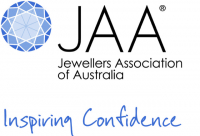What you need to know when buying a sapphire.
By Melinda King. Feb 2021
Sapphire is our favourite coloured gemstone at Bill Hicks Jewellery and is a great choice for an engagement ring due to its durability and well known for its unique yet timeless appeal.
With origins from all over the world, they are available in a spectrum of rainbow colours. It’s no wonder it can be confusing when finding and selecting the perfect stone. Here is our guide on how to choose the right gem for you and some tips on which characteristics are most important when evaluating a sapphire.
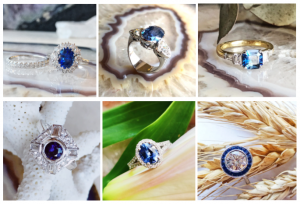
Colour:
Firstly, colour is the most important. Sapphires are a mineral called Corundum and they come in every colour of the rainbow, including colourless except for Red, which is better known as Ruby. They also have an optical phenomenon called Pleochroism, meaning they can have a colour change depending on the sort of light and angle they are viewed under. These sapphires will change from blue tones in fluorescent lighting to purple or pink in daylight light. Or from green to blue, or colourless to pink. Or in the case of Padparadscha sapphire, from Orange to Pink.
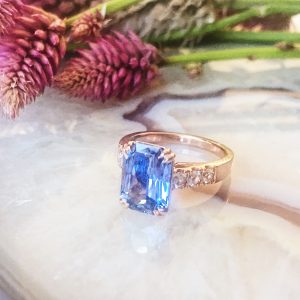
This stunning 4 carat Lavender sapphire showed blue to violet colour change.
Each colour has it’s own ideal characteristics – Classic Ceylon Type Blues, Velvet Blue, Cornflower Blue and Lavender Blue should have a pure blue to violet hue. They ideally should have a strong vivid saturation of colour, with medium to medium-dark tone. It is considered undesirable to have green or grey tones in these stones.
The saturation should be as intense as possible without making the stone dark. It should have enough brilliance (light return) to ensure that it sparkles.
Australian Blue Sapphires are usually quite intensely saturated in colour and can have a deep Royal Blue colour. The most desirable Australian Blue Sapphires are a deep blue and have an electric blue flash, and may have green or grey undertones. These stones can get so dark they appear black, and are usually a less expensive option than the Ceylon type Sapphire, although they have increased in value and popularity recently.
Teal Sapphires have become extremely popular, and are ideally a perfect 50 – 50 mix of blue green. They should be vivid, brilliant and with an even coloured hue. These are mostly Australian sourced making them an excellent choice for those wanting a sustainable ethical gem. Green Sapphires are also uniquely Australian in origin and are just beautiful and come in all shades of grass to olive green.

Parti Sapphires are also increasingly popular, and display what is known as colour zoning. These are growth patterns in the stone, and can create a bi-coloured stone that shows multiple colours from yellow through green to blue, or colourless through pink to blue.
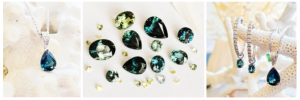
These are usually not as valuable as stones that show even colour, but can be unusual and are definitely unique.
Pink sapphires can range from an intense hot pink that edges on the intensity of ruby to a soft pastel pink, and depending on what is fashionable, prices can vary dramatically. Generally intense vivid pinks will be more valuable, however in recent years the soft peachy pinks have become so sought after that they are often more expensive in larger carat sizes.
The most sought after of these is known as a Padparadscha Sapphire and must be unheated, and naturally exhibit both hues of orange and pink to qualify. These stones are more valuable than the traditional Blue Sapphires, and are increasingly difficult to source. The more intense the colour and brilliance, the more valuable, and they are said to be the colour of the perfect sunset. At Bill Hicks Jewellery we stock a number of these rare and beautiful gems, and can source them with certificates for those who appreciate their exquisite beauty.

Naturally Orange and Yellow Sapphires are the least well known, and are quite stunning. The brighter and more vivid the more desirable. However it is best to ask if the stone has been Beryllium Treated as this is often used to make softer colours appear brighter and more saturated.
Cut:
With all gemstones a good cut will bring out the true beauty of the colour, and a bad cut can ruin it completely. Ideally the cut will allow the light to reflect back out the table facet, and give as much brilliance as possible. This is important when choosing a sapphire for an engagement ring as you want it as bright as possible. If a stone is cut too shallow or its angles are not correct it can create a windowing effect where the light falls out the back of the gem, instead of bouncing back off the pavilion facets. This will leave a lighter patch in the centre of the gem, and you may end up seeing the setting or ring or your finger under the stone once it is set.
On the other side if the Sapphire is cut too deeply it may have what is called extinction. This is when facets appear dark, and is sometimes done to increase the depth of colour in paler stones. Ideally it should not be more than 25% of the stones’ facets.
Symmetry and shape are secondary considerations with sapphires, however with traditional cuts, symmetry will enhance the visual appeal and value.
Clarity:
Being natural gems, Sapphires have a number of common inclusions, and most will have some eye visible fractures, minute crystals or liquid inclusions. As long as these are not in a place that distracts the eye, or causes concern for the setting then they won’t affect the value.
The highest grading is considered eye clean, then slightly included, which may have small inclusions but are still considered high quality stones, and then moderately included which then drop in value.
To check for inclusions, hold the stone in tweezers, and gently rock the stone back and forth under a strong light, and if any obvious inclusions jump out at you or detract from the overall appeal then perhaps that stone isn’t the one for you.
Carat:
Sapphires are a denser mineral than diamond, so in terms of size most people choose to go bigger rather than smaller when it comes to a sapphire engagement ring.
With the Teal, Parti colour, Wattle Green and Australian Blues they are significantly less expensive than diamonds and most clients are often thrilled to discover that 2-3 carat size is within their budget.
With the higher valued Ceylon Type sapphires many choose the smaller, more vivid blues between 1 – 2 carats in size, and depending on their style add a halo of fine white diamonds for a classic Princess Diana style ring.
With the rare Padparadscha Sapphires budget is always a consideration as these are typically more expensive than diamonds if they are of high quality. With value depending on the vividness and intensity we find our clients aesthetically choose colour over carat size when looking for the perfect gem.

Design:
Selecting your sapphire is the first step in creating the perfect Sapphire engagement ring. Our experienced designers are passionate about expressing the inner beauty of each gem, tailoring the design to suit her personal style, and making the experience fun and memorable.
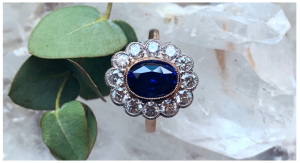
At Bill Hicks Jewellery all our designers are qualified gemmologists and will guide you through the design process making it a fun and informative experience. And with our team of expert craftspeople you can be assured the end result will be truly exquisite.
To enquire about viewing some Coloured gemstones, or to make a complimentary design appointment please click here:

